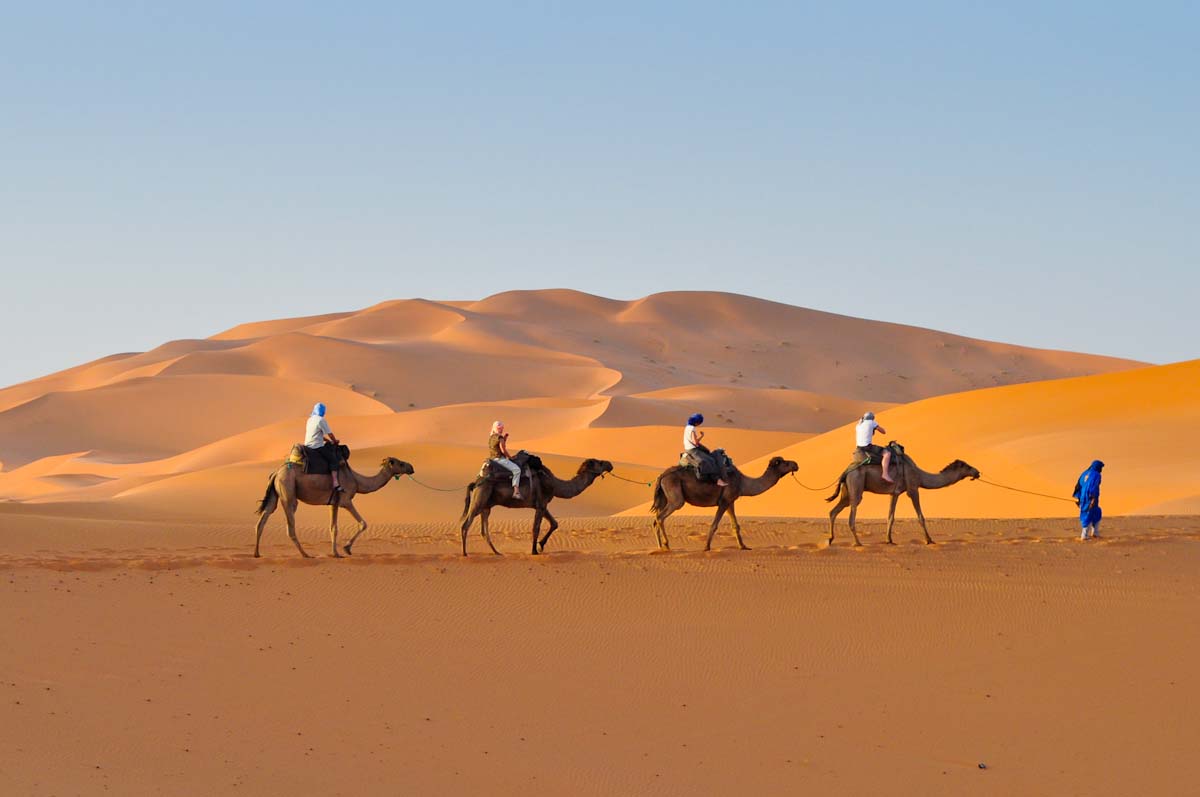Morocco, the gateway to Africa, is a land of fascinating contrasts. From the golden sands of the Sahara Desert to the snowy peaks of the Atlas Mountains, this North African gem offers experiences that are as diverse as its landscapes. If you’re considering a trip to Morocco, here are 12 fun facts that will undoubtedly inspire your journey.
1. Morocco’s Vast Size and Geographic Diversity
Morocco covers an area of 172,410 square miles, making it a country of striking geographical diversity. This includes rugged mountains, coastal beaches, lush plateaus, and vast desert landscapes. With the inclusion of Western Sahara, the country spans 279,250 square miles—larger than California but smaller than France. Geographically, Morocco is bordered by Algeria to the east, the Mediterranean Sea to the north, the Atlantic Ocean to the west, and Mauritania and Mali to the south. Whether you’re drawn to the peaceful coast or the arid Sahara, there’s a region of Morocco to match your travel desires. When planning your trip, don’t forget to book your stay at one of the many hotels in Marrakesh, a city that blends history and modernity.
2. Skiing in the Desert? Yes, It’s Possible!
It might sound strange, but Morocco offers skiing—yes, skiing—on the African continent! The Atlas Mountains stretch across Morocco, Algeria, and Tunisia, and their snow-capped peaks are home to Africa’s highest ski resort, Oukaimeden, just 50 miles from Marrakesh. With slopes ranging from 8,500 to 10,500 feet, Oukaimeden is a hidden gem for those seeking a winter wonderland experience. But if you’re more of a trekked terrain type, don’t miss Mount Toubkal, Morocco’s highest peak at 13,671 feet. Toubkal is a favorite among trekkers year-round and offers a thrilling climb with breathtaking views.
3. The Richness of Language in Morocco
Morocco’s official languages are Berber and Moroccan Arabic, also known as Darija. While Classic Arabic is not the country’s official language, it remains a significant part of religious and scholarly contexts. Interestingly, Darija can be quite different from Classical Arabic, and it can be challenging for those fluent in the latter to understand it. French is widely spoken, especially in the north, due to Morocco’s historical ties with France. You’ll also hear Italian, Spanish, and even German and Dutch, reflecting Morocco’s vibrant tourism industry.
4. Tea: More Than Just a Drink
Moroccan culture is steeped in the ritual of tea-drinking. The most popular tea, Maghrebi mint tea, is a concoction of green tea, fresh spearmint leaves, and an abundance of sugar. Tea is not just a beverage here; it’s a symbol of hospitality and social connection. Tradition dictates that tea should be served in three glasses, each representing life’s different stages. The head male of the family often serves the tea to guests, showcasing the warmth and generosity of Moroccan society.
5. The World’s Oldest University
Did you know that Morocco is home to the oldest continuously operating university in the world? The University of al-Kairaouine, founded in 859, is located in the city of Fez and remains an important educational institution today. It was initially established as a madrasa (Islamic school) and became the first university to offer degrees in subjects like astronomy, medicine, and mathematics. Morocco’s literacy rate, particularly among young people, is relatively high, with 88% of males and 74% of females between the ages of 15-24 able to read.
6. A Cultural Melting Pot
Morocco’s rich cultural heritage is shaped by its mix of Berber (Amazigh) and Arab influences. Around 30% of Moroccans identify as Berber, with their language, traditions, and crafts playing a significant role in the country’s identity. The Arab influence in Morocco increased significantly after the Muslim conquest in the 7th century. More recently, Morocco has become home to a large number of immigrants from sub-Saharan Africa, adding to its cultural richness.
7. A Long Line of Royalty
Morocco boasts one of the world’s oldest ruling dynasties. The current royal family has been in power since 1631, claiming descent from the Prophet Muhammad. King Mohammed VI, the 23rd monarch, ascended to the throne in 1999. Under his leadership, Morocco has evolved into a constitutional monarchy. The country was a French protectorate until 1956, and it officially became a constitutional monarchy in 1957.
8. Morocco: The Hollywood of Africa
Ouarzazate, located in the heart of Morocco, is home to the Atlas Film Studios, the largest film sets outside of Hollywood. Known as the “Gateway to the Sahara,” Ouarzazate has been the backdrop for many iconic films and TV series. From The Mummy and Gladiator to Game of Thrones, the stunning desert landscapes and ancient kasbahs have attracted filmmakers from around the world. If you’re a movie buff, this is a must-see destination!
9. Moroccan Cuisine Etiquette
Moroccan cuisine is a delightful fusion of Arab, Berber, Mediterranean, Andalusian, and European influences. Food is often served in large communal platters, and it’s considered impolite to refuse meat when offered. Bread is a staple in Moroccan meals, used to scoop up food in place of utensils. The evening meal is the main meal of the day and is traditionally served late, often after sunset. Don’t be surprised if you’re invited to join in on this communal feast—sharing food is an important part of Moroccan hospitality.
10. The Key Exports of Morocco
Morocco is known for its natural resources, and two of its most famous exports are dates and argan oil. The country produces a staggering 9,000 tons of dates annually, making it one of the world’s largest exporters of the fruit. Argan oil, derived from the nuts of the argan tree, is another key export and is widely used in cosmetics and cooking. Known for its skin-nourishing properties, argan oil is highly sought after around the world.
11. Four Imperial Cities
Morocco is home to four imperial cities, each once serving as the capital of the country: Rabat, Fez, Meknes, and Marrakesh. Today, Rabat is the political capital, while Marrakesh is known as the cultural capital. Fez is home to one of the world’s oldest medieval cities and is a UNESCO World Heritage site, while Meknes, known for its grand architecture, remains a historical gem. Casablanca, the largest city in Morocco, is famous for the Hassan II Mosque, one of the largest mosques in the world, and is home to the only Jewish museum in the Arab world.
12. The Barbary Lion: A Symbol of Strength
Morocco’s national animal, the Barbary lion, is unfortunately extinct in the wild. However, efforts to preserve this majestic creature continue in zoos and conservation sites. The lion once roamed the Atlas Mountains and is a symbol of Morocco’s strength and courage. In fact, the Moroccan flag, which features a red background with a green star, represents bravery, strength, joy, and love—and is a nod to the five pillars of Islam.



































